Complete Solutions to REVIEW QUESTION of chapter CIRCULATORY SYSTEM of Class 10 book with complete answers and questions
| Class 10 | BIOLOGY |
| Chapter | CIRCULATORY SYSTEM |
| EVERGREEN PUBLICATION | REVIEW QUESTION |
| Number Of Questions | 100 |
| Academic Year | 2023-24 |
Define the following:
Diapedesis
View SolutionDefine the following:
Thrombosis
View SolutionDefine the following:
Pacemaker
View SolutionDefine the following:
Systole
View SolutionDefine the following:
Haemophilia
View SolutionDefine the following:
Leucopenia
View SolutionDefine the following:
The mineral element essential for the clotting of blood
View SolutionEnumerate various steps involved in blood clotting.
View SolutionName the arteries that supply blood to the nearest organ, kidney and liver.
View SolutionWhat do you mean by portal vein and portal system?
View SolutionWhat is the need of a hepatic portal system?
View SolutionDifferentiate between the following pairs on the basis of what is indicated within the brackets:
Artery and vein (direction of blood flow)
View SolutionWrite the differences between:
(a) Blood and Lymph
(b) Open and Closed system of circulation
(c) Systole and Diastole
(d) P-wave and T-wave
View SolutionDefine the following:
Thrombosis
View SolutionDifferentiate between Pulmonary and Systemic circulation
View SolutionDifferentiate between Erythrocytes and leucocytes of mammals
View SolutionMark the odd one in each series :
RBC, WBC: platelets, cartilage.
View SolutionTabulate differences between:
LUBB and DUP (Names of valves whose closure produce sound
View SolutionThe given diagram is highly diagrammatic representation of mammalian heart. In this diagram
Name the parts marked 1-12.
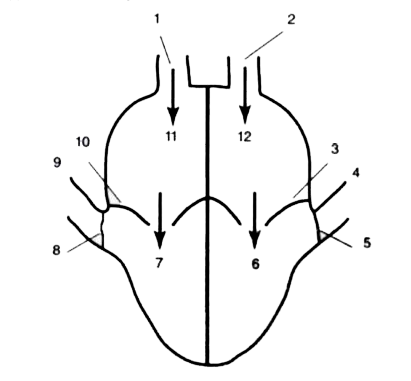
View SolutionThe given diagram is highly diagrammatic representation of mammalian heart. In this diagram
(##EVR_ANM_ICSE_BIO_X_C07_E01_020_Q01.png" width="80%">
What do the arrows indicate ?
View SolutionThe given diagram is highly diagrammatic representation of mammalian heart. In this diagram
(##EVR_ANM_ICSE_BIO_X_C07_E01_021_Q01.png" width="80%">
Name the valves that guard openings in the heart.
View SolutionThe given diagram is highly diagrammatic representation of mammalian heart. In this diagram
(##EVR_ANM_ICSE_BIO_X_C07_E01_022_Q01.png" width="80%">
From where do the parts numbered 1- 6 receive blood ?
View SolutionWhere is SAN located and what is its function ?
View SolutionWhere does a body weigh more – at the surface of the earth or in a mine?
View SolutionWhich of the following is an anticoagulant
and checks blood coagulation in blood vessels ?
View SolutionExplain :
Universal recipient
View SolutionWhich is the correct sequence of arrangement of types of WBC in decreasing order term of number per `mm^(3)` of human blood?
View SolutionFill in the blanks :
………… , ……….. And ……….. Enter the right auricle whereas ……….. enters the left auricle.
View SolutionFill in the blanks .
(i) Deletions and insertions of base pair of DNA causes `"_______"`.
(ii) A classical examples of point mutation is `"______"`.
View SolutionFill in the blanks :
…………. leaves the left ventricle.
View SolutionBicuspid valve is present between
View SolutionLeukocytes can squeeze out of blood capillaries. This process is called
View SolutionFill in the blanks :
…………. vein is that which starts as well as terminates as capillaries.
View SolutionFill in the blanks :
Largest (in number) WBCs in the blood are ………
View SolutionThe largest RBC's have been seen in
View SolutionFill in the blanks :
The blood vessel that begins and ends in capillaries is the.....
View SolutionFill in the blanks :
Oxygen combines with haemoglobin resent in RBC and forms …………..
View SolutionFind the odd one out :
Haemoglobin, prothrombin, fibrinogen and thrombokinase.
View SolutionFind the odd one out :
Hepatic artery, renal artery, coronary artery and pulmonary arteries,
View SolutionFind the odd one out :
Renal vein, hepatic vein, mesenteric and hepati portal vein.
View SolutionFind the odd one out :
Superior vena cava inferior vena cava, coronary Sinus and pulmonary veins,
View SolutionFind the odd one out :
Bicuspid valve SAN A-V node and bundle of His
View SolutionFind the odd one out :
Thick walled narrow lumen, muscular walls and Semilunar valves presont.
View SolutionFind the odd one out :
Monocytes, lymphocytes, erythrocytes and basophils
View SolutionFind the odd one out :
Transportation of digested food. Excretory products. hormones and oxygen.
View SolutionFind the odd one out :
Bicuspid valve most thick-walled receives exygenated blood and beginning of pulmonary arch
View SolutionFind the odd one out :
Thin walled, wide lumen, collapsible and valves absent
View SolutionLumen, muscular tissue, connective tissue, pericardium
View SolutionAssertion : The process of clotting can occur in absence of all cellular elements except platelets
Reason : Vitamin K is essential for blood clotting.
View SolutionErythropoiesis starts in
View SolutionName the following:
The vein that carries oxygenated blood.
View SolutionName the following:
The valve present in the opening of inferior vena cava
View SolutionRh factor was discovered by
View SolutionName the following:
The scientist who identified different types of blood groups.........
View SolutionName the type of cells that produce antibodies.
View SolutionName the following:
The gas that reduces oxygen carrying capacity of the blood.
View SolutionName the vitamin which is vital for the clotting of blood?
View SolutionThe duration of cardiac cycle in a normal man is
View SolutionName the following:
The vein which drains the blood from the intestine to the liver
View SolutionName the following:
Blood vessels carrying blood to the left atrium
View SolutionName the following:
The blood vessel which supplies blood to the liver
View SolutionName the compound formed by haemoglobin with carbon dioxide.
View SolutionWhy is the heartbeat rate equal to the arterial pulse rate?
View SolutionExplain briefly :
Why are capillaries thin walled ?
View SolutionA mature mammalian erythrocyte characteristically has :
View SolutionExplain briefly :
Pulse.
View SolutionExplain briefly :
Blood flows in arteries in spurts and is under pressure
View SolutionThe figures given below are crose-coctions of blood vessels

Identity the blood vessels A B and C.
View SolutionThe figures given below are crose-coctions of blood vessels

Name the parts labelled 1 – 4.
View SolutionThe figures given below are cross-sections of blood vessels
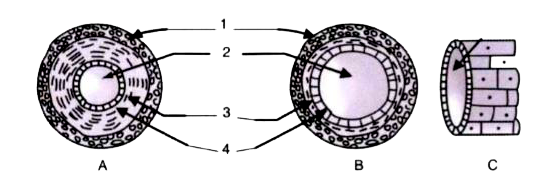
Venlion two structural differences between A and b
View SolutionThe figures given below are cross-sections of blood vessels
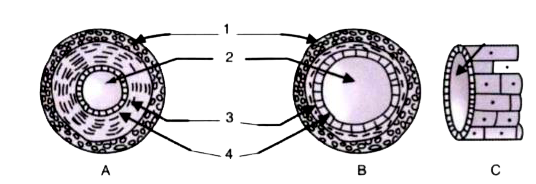
Name the type of blood that flows (a) through A. (B) through b
View SolutionThe figures given below are crose-coctions of blood vessels

In which of the above vessels referred to in v above Goes Oxchange of gases actually take place?
View SolutionThe figures given below are cross-sections of blood vessels
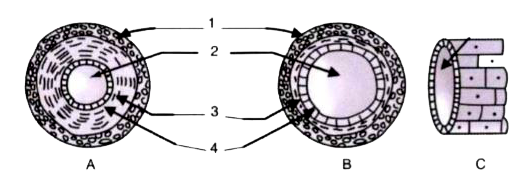
Which category of blood vessels have valves in their inner lining?
View SolutionGiven below is a diagram of the external features of the heart:

Name the parts 1 to 7.
View SolutionGiven below is a diagram of the external features of the heart:

What happens if the coronary artery gets an internal clot?
View SolutionGiven below is a diagram of the external features of the heart:
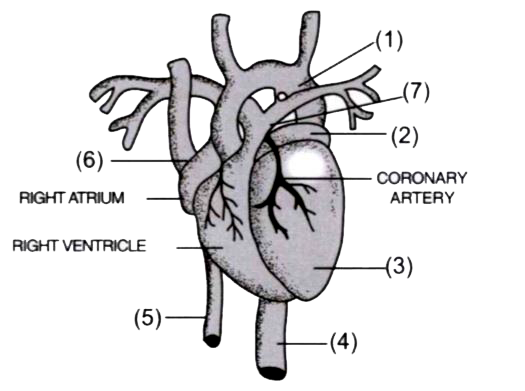
What type of blood does '5' carry?
View SolutionGiven below is a diagram of the external features of the heart:
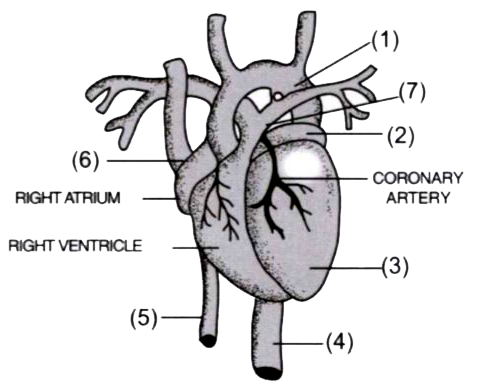
Mention one structural difference between 5 and 4
View SolutionThe diagram given below shows part of the capillary bed in an organ of the mammalian body. Some of the blood arriving at the capillaries at point labelled A moves out into the spaces between the tissue
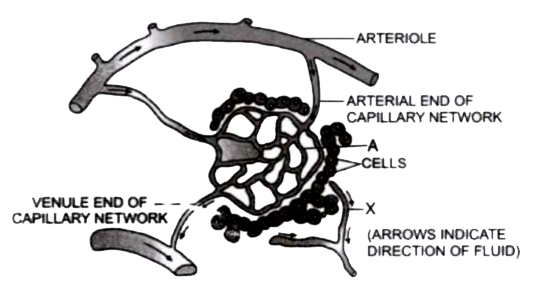
When the liquid from the blood surrounds the cells, What is it called ?
View SolutionThe diagram given below shows part of the capillary bed in an organ of the mammalian body. Some of the blood arriving at the capillaries at point labelled A moves out into the spaces between the tissue

Name any one important component of the blood which remains inside the capillaries and fails to move out into the spaces.
View SolutionThe diagram given below shows part of the capillary bed in an organ of the mammalian body. Some of the blood arriving at the capillaries at point labelled A moves out into the spaces between the tissue

Some of the liquid surrounding the cells does not pass directly back into the blood but eventually reaches it by another route through vessel X. Name the fluid present in vessel X.
View SolutionThe diagram given below shows part of the capillary bed in an organ of the mammalian body. Some of the blood arriving at the capillaries at point labelled A moves out into the spaces between the tissue
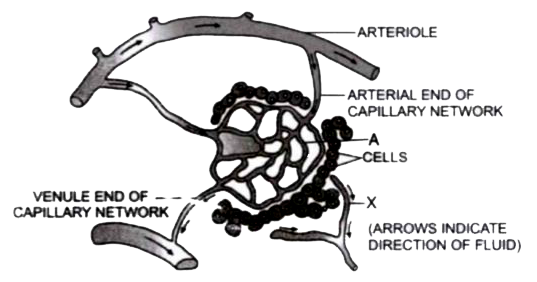
State two important functions performed in our body by the fluid present in vessel X.
View SolutionThe following simplified diagram refers to the outline plan of the circulation of blood in a mammal, Study the diagram and write the number and the name of the blood vessel in each case as mentioned under.
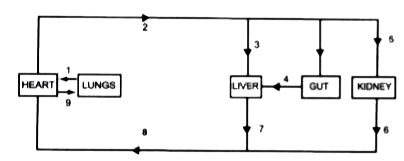
Several hours after a meal containing a lot of protein, which vessel will contain the highest concentration of urea?
View SolutionThe following simplified diagram refers to the outline plan of the circulation of blood in a mammal, Study the diagram and write the number and the name of the blood vessel in each case as mentioned under.
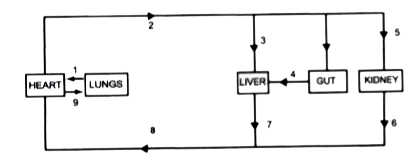
Which vessel contains the highest concentration of amino acids and glucose soon after a meal?
View SolutionThe following simplified diagram refers to the outline plan of the circulation of blood in a mammal, Study the diagram and write the number and the name of the blood vessel in each case as mentioned under.
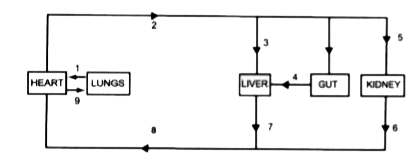
Which vessel begins and ends in capillaries ?
View SolutionThe following simplified diagram refers to the outline plan of the circulation of blood in a mammal, Study the diagram and write the number and the name of the blood vessel in each case as mentioned under.

Which vessel will contain the smallest number of red blood cells per unit volume of blood ?
View SolutionThe following simplified diagram refers to the outline plan of the circulation of blood in a mammal, Study the diagram and write the number and the name of the blood vessel in each case as mentioned under.
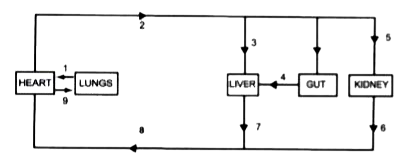
in which vessel will the blood carry the most oxyhaemoglobin
View SolutionGiven below the simplified pathway of the circulatory system of man:
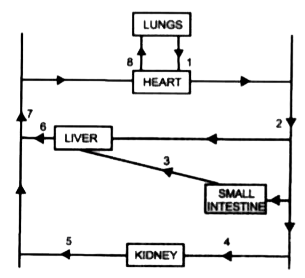
Name the blood vessels labelled 1. 3. 6. and 7.
View SolutionGiven below the simplified pathway of the circulatory system of man:
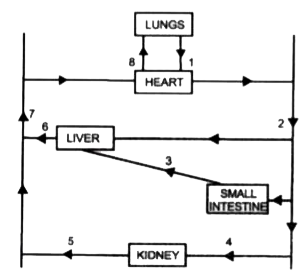
Name the blood vessel that supplies the walls of the heart with oxygen.
View SolutionGiven below the simplified pathway of the circulatory system of man:

Draw a neat labelled diagram of the blood vessel numbered 2' as seen in a cross-section.
View SolutionGiven below the simplified pathway of the circulatory system of man:

Mention one structural difference between blood vessels numbered 4 and 5
View SolutionState main functions of :
Coronary artery
View SolutionState main functions of :
Thrombocytes
View SolutionState main functions of :
Give the exact location of Mitral valve.
View SolutionGiven below is a simple diagram of the circulation of blood in a mammal showing the main blood vessels, the heart, lungs and body tissues. The

blood vessels, labelled 6, contain deoxygenated blood and the valve leading to it has three semi- lunar pockets
Name the blood vessels or organs marked by numbers 1 to 8
View SolutionGiven below is a simple diagram of the circulation of blood in a mammal showing the main blood vessels, the heart, lungs and body tissues. The
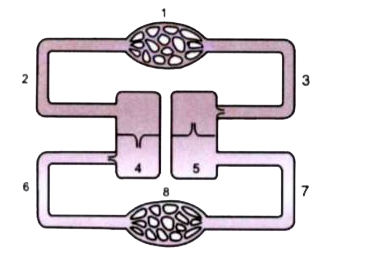
blood vessels, labelled 6, contain deoxygenated blood and the valve leading to it has three semi- lunar pockets
What is diastole
View SolutionGiven below is a simple diagram of the circulation of blood in a mammal showing the main blood vessels, the heart, lungs and body tissues. The

blood vessels, labelled 6, contain deoxygenated blood and the valve leading to it has three semi- lunar pockets
What is diastole
View SolutionThe diagram given below represents a certain category of blood vessels showing the role of a special structure in their walls :
 Describe the role of these structures.
Describe the role of these structures.
View SolutionThe diagram given below represents a certain category of blood vessels showing the role of a special structure in their walls :
 Describe the role of these structures.
Describe the role of these structures.
View SolutionThe diagram given below represents a certain category of blood vessels showing the role of a special structure in their walls :
 Describe the role of these structures.
Describe the role of these structures.
View SolutionThe diagram given below represents a certain category of blood vessels showing the role of a special structure in their walls :
 Are these structures present in any other kind of blood vessel ? If so, name it.
Are these structures present in any other kind of blood vessel ? If so, name it.
View Solution
REVIEW QUESTION questions and complete solutions for chapter CIRCULATORY SYSTEM of EVERGREEN BIOLOGY (ENGLISH) of Class 10